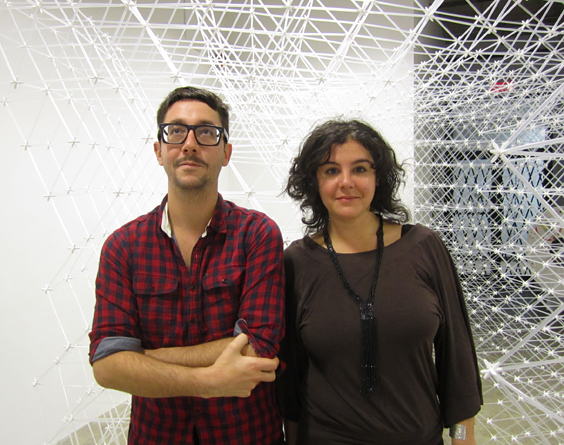
Yann Pocreau and Claudine Khelil with installation “LINX” by Patrick Martinez at Centre Clark. Photo by M-KOS
Montreal/Brooklyn is the project title for a visual art exchange between two North American cities of the same name, initiated by artist-run centre Clark. Their first public event kicked off in October from Montreal to then reach Brooklyn in January 2013 and altogether showcase 40 artist works within 16 institutions. More than two years in the making, the painstaking efforts to make this project happen have finally paid off with excitement from the public as well as the press. M-KOS interviewed Clark coordinators Claudine Khelil and Yann Pocreau, to grasp an insider’s view of Montreal/Brooklyn.
M-KOS [MKOS]: A few weeks have passed already since the start of Montreal/Brooklyn in October. How was the public’s reaction so far?
Yann Pocreau [YP]: It’s been great. We had a lot of media coverage and people are passing on the buzz. We didn’t really expect that. We even had some coverage in France.
MKOS: That’s fantastic. Can you tell us how this project started out?
Claudine Khelil [CK]: We were in New York visiting some galleries, and we approached one of them whose work we really liked. First we proposed the gallery director of Parker’s Box to do some exchanges with Clark. Then after a long discussion we started talking about possibilities and decided to go bigger, to do an exchange project with a substantial amount of structure.
YP: We not only wanted to show some artists but the Montreal art scene as a whole, to show it in equal terms with the one in Brooklyn. We wanted to show a sample of what we have here in terms of institutions, so we picked a few commercial galleries, artist-run centres, a university-based gallery, another small institution as well as the museum of contemporary art. First of all we thought it would be fun to invite great international artists to Montreal. We also wanted to show different kinds of artists in different contexts, for example, juxtaposing the museum and the artist-run centre, two different worlds in one event.
Our discussions carried on, then Alun Williams, the director of Parker’s Box, told us that he had done something similar in 2001 called “Paris/Brooklyn†which was an exchange of video works involving 20 galleries. He suggested that we should do a similar event, perhaps working again with a 20/20 ratio.
CK: yes, and this would give an overview of the different art scenes – a meeting between cities, structures, artists and so on.
YP: It is also a great opportunity to show Montrealers what our art scene is about, to give an overview of what we are living, by showing it within structures that never happened here before. So we included a programme called ‘Saturday Outings’, a visiting tour of different shows, with studio visits, walking around from venue to venue, having discussions and so on, really to demystify our art scene. It is exciting for us in terms of outreach to the public as well, to let Montrealers discover something about their scene through this event, and also compare it with the one in [greater] New York. Of course there are always aspects to envy about New York but works here are strong enough to show side by side with New Yorkers, to gives a sort of incentive to Montrealers to think that way.
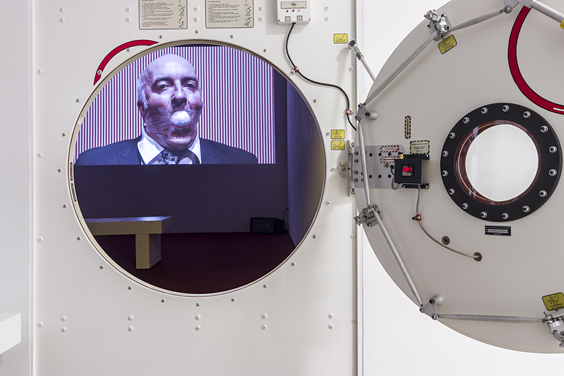
Installation view at Centre Clark, 2012. Steven Brower, The Hatch, 2012 (The SAS) and Mathieu Beauséjour, Don’t worry darling, there will be more riots in the spring, 2012. (Video) Photo by Sébastien Lapointe. Courtesy the artists and Centre Clark.
MKOS: So it started out of mutual interest…
YP: Yes. At first Claudine and I thought we would have to pitch our project explaining what the Montreal art scene is about, but they were all really excited about Montreal because they find Montreal has an exciting vibe.
CK: In fact, the music scene in Montreal is already very close to the one in Brooklyn, and that opened the door in a way.
MKOS: That reminds me about one of the articles in the Telegraph, a UK newspaper, which had a headline “Montreal is the new Brooklynâ€, talking about the indie music scene here.
CK: I think, generally, we have a similar vibe and political stance. When Montreal people go to Brooklyn, we don’t have a big culture shock. We share similar interests and preoccupations.
MKOS: So, have there been many exchanges between these two cities before?
YP: For visual arts, this kind of event is the first in almost 20 years. In fact in 2001, there was supposed to be an event called La semaine de Quebec which planned to open in September at the World Trade Centre two days after the 9/11 but of course that never happened.
CK: It’s been long overdue to organize such an event, considering the fact we are both North Americans, geographically very close, only 6 hours drive away from each other. So, it’s about time we explore what’s happening in the visual arts scene in the neighbouring cities. The fact that we are both North Americans but in a really different way, is also an interesting thing that this exchange raises.
MKOS: You [Yann] also mentioned in a recent article in Canadian Art magazine that the art scenes in Montreal and Brooklyn are as similar as they are…
YP: …super different.
MKOS: Can you tell us more about that?
YP: As Claudine said the vibe and the issues that the artists work with could be a little similar. For the scale of the city, of course, we cannot compare Montreal with Manhattan, but Brooklyn has some similar characteristics: it’s easy going, very alive, and there are more artist studios. Also they do more experimental works which could be a little similar to Montreal. But in fact it’s way more expensive to live there which means that many artists have to jump into the market straight after finishing art schools, without having much time to experiment. And art organizations don’t operate in the same way as we do. With agenda, for example, they seem to do one thing and then quickly do another, in super rush all the time. The way we show things is very different, too. In Montreal we programme at least a year and a half in advance, of course we get public funding and grants to enable us to take time. We work in big teams and we spend fair amounts of time to talk to artists. Over there they seemed to be juggling more. There are only a few non-profit spaces in New York and these galleries have to work pretty hard since the grant system is not so well defined as here, which results creating a lot of competition.
CK: Especially these days, they are feeling the impact of the financial crisis. So in terms of funding, we are kind of lucky to have more government support for culture. But, it’s a much richer mix there because so many artists are coming in from different places and backgrounds, doing their thing. Surprisingly they can be very experimental, too. They really take some chances. When artists have to sell their experimental works, is the public more open towards such works, non-object based works? That’s an open question to me. [laugh]
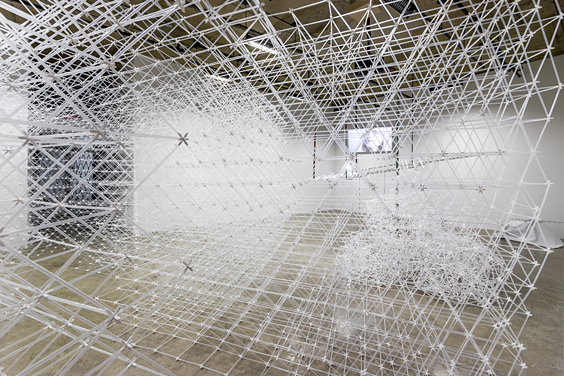
Patrick Martinez, LINX, 2012 (Straw installation); Julie Favreau, Anomalies, 2012 (video). Exhibition presented at Centre CLARK. Courtesy of the artists and Centre Clark. Photo by Sébastien Lapointe
MKOS: At one of the opening receptions Oli Sorenson (Other half of M-KOS) spoke to Brooklyn coordinator Alun Williams who was impressed with how much support this project got from Canadian public funding, at the National, provincial and municipal level. Eight out of ten of Montreal/Brooklyn’s public funders came from Canada.
YP: He may not know how much work we had to do to get all the funding, sponsorships, partners both public and private, altogether 28 of them in order to raise enough money for this project. It was about two and a half years of work and at the same time we had to work on our day-to-day operations of the Clark centre.
CK: Surely we’ve been well supported but it was a lot of work.
MKOS: When you approached these councils were they from the start very enthusiastic about this project? Or did you have to work hard to persuade them?
CK: In fact, we were very surprised that they were pretty open and enthusiastic towards this project from the start that assured us that we were on the right track.
MKOS: You mean all of them, national, provincial and municipal bodies?
YP: Especially the provincial. The Québec arts council has been trying to develop a bridge between New York and Québec for many years and waiting for such project to come up which we didn’t know before our proposal.
CK: We allowed this at the right moment, I think.
YP: They were very excited especially that this project was brought up by an artist-run centre because the Québec Arts Council works only with artists, researchers and artist-run centres. They helped us a lot throughout the project. Firstly, they paid for Montreal artists to travel to Brooklyn to meet the partner organizations. They helped us push for the ministry to get a little more money for this project. They have given us tremendous support.
MKOS: Did you also get involved in the curatorial decisions?
YP: No. We let the galleries and institutions work together and curate the shows.
MKOS: How did you decide to pair each venue?
CK: At first, Alun and we picked some galleries and institutions to participate in this event. Then one weekend we brought directors of the Brooklyn galleries to Montreal to see the space and meet people here. This was supported by the Québec delegation in New York. Then weekend after that, it was our turn to go to New York. After all of us had seen the spaces, we discussed the pairing of the different spaces.
YP: It was like a couple of speed dating weekends.
CK: After the second meeting, it was pretty clear which galleries would match together. I think the matching worked well in regard to the type of works they are showing, the missions, the type of structures and so on. But we had some surprises like the Museum of Contemporary Art that was matched with an institution with a different structure, that is not a museum.
YP: Instead of making a pair between the same structures we arranged the categories in a different way.

Janet Biggs, Fade to White, 2010. Single channel video projection. Exhibition Janet Biggs is presented by Musée d’art Contemporain de Montréal. Courtesy of the artist.
MKOS: How did a major art institution like the Museum of Contemporary Art get involved in your project? Did you approach them?
YP: One of the curators of the Museum, Mark Lanctôt had met Alun ten years ago regarding a possible project like Montreal/Brooklyn. So Alun knew Mark, and we thought it would be interesting if the museum were part of this project. At first the Brooklyn Museum was getting involved but that didn’t happen because of financial problems. We approached the museum of contemporary art in Montreal and finally we didn’t work with Mark but another curator, Lesley Johnston. We wanted to have a range of institutions in this project. We are lucky because the museum also has an interest for working with communities. They were very helpful for the project.
MKOS: What was the most difficult task for organising this event?
CK: The fact that we are in different cities, with different freedom of actions, different ways of doing things, like at the beginning of the project, we wanted to curate a little more or have a bigger team but we realised that Brooklyn was not interested in that.
YP: They do their own stuff.
CK: They do their own stuff more organically. Despite of the fact that people are working and working all the time, they work in much more organic way than we do – the way they think and organize things. Sometimes it was a little bit difficult to fix misunderstandings.
MKOS: Have your ideas or opinions towards Brooklyn changed over time? What did you make out of this project?
YP: I think we are going to answer this question after the Brooklyn show finishes, which starts in January next year. Because we are just hosting the Montreal exhibitions right now and the whole project is not completed yet.
CK: One thing for sure is that during this project we realized we [Montrealers] also have a strong art scene, our artists create strong works. Of course, when we go to New York we see lots of artists but it’s not necessarily about the dissemination that makes a strong artist or art scene. We are proud to say the artists here are also strong and create a strong art scene. We don’t need to feel underrated.
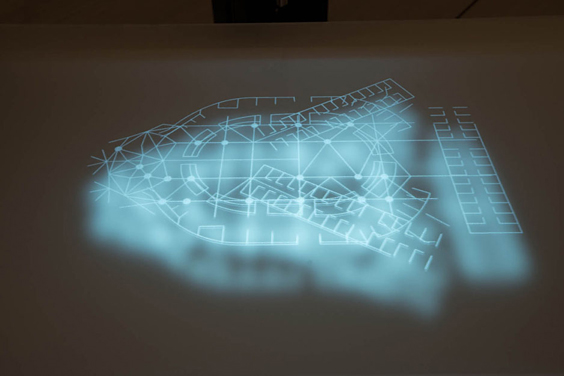
Sébastien Cliche, Le chateau, 2012. Audio visual installation. Exhibition presented at Optica. Courtesy the artist. Photo by Paul Litherland
MKOS: Montreal can provide an artist-friendly environment as well as a platform for artists to work, research and develop. For example, the cost of living and studio rents are much cheaper and they have better public funding systems.
YP: But we don’t get much dissemination. Let’s say, we don’t have many curators coming from outside to see our work. We lack visibility and exposure on the international level. Montreal is a very good place to work but maybe it is not the best place to develop an international career, to be seen by curators we cannot compare to New York for this.
MKOS: Brooklyn surely has more advantage for that by being right next to Manhattan. But how do you think the different ways that art is funded in the respective cities changes the way artists make their production?
YP: In the case of Montreal, we have more time to develop, experiment and do research. Québec’s contemporary art scene is known to be strong in installation, video and performance art for example, which has less chance of selling than object based work
MKOS: Because artists are not structured by the art market hype or under pressure of selling works so much?
YP: It’s been like that for years.
CK: I think it is also a question of generations. Even these days the commercial art scene here or the art market has been developing slowly and it is still very small. Many mid career or older generation artists are still doing their own research and many of them are not so driven by the market but the younger, emerging artists who have just come out from the art schools, want to put themselves forward, be more outspoken about their work, try to sell, try to make living and so on. More and more artists understand that the role of artists is not only to create and feed their research but also to promote themselves in trying to find a gallery, you know, this business side of the work.
MKOS: So this event could open up many possibilities including career boost for Montreal artists, even though it may not be on the project’s agenda?
CK: Hopefully, this event will open a few little doors for new interests from outside. Locally this event is really big, fused the milieu by putting all kinds of structures together. Let’s see, what will it be in a big city like New York or even Brooklyn, how will they perceive our artists and art scene.
YP: We’ll find out in January.
CK: I know it will open networks between artists, between galleries and between the two cities. This is the first step and I’m sure it is the beginning of something. We’ll see.

William Lamson, Time is like the East River, 2009. Exhibition presented at Galerie Division, Montreal. Courtesy of the artist.
MKOS: Are you going to show the same works in Brooklyn as here?
CK: Yes. Same works but of course it will be slightly different set ups depending on the respective spaces over there.
MKOS: What’s next for Montreal/Brooklyn? Is this a one off project? Or do you foresee some possibilities for annual or biennial events? Or would you want to do this again with other cities?
YP: We could make it into a regular event but has to be done differently. I think we need a bigger team. Perhaps someone else could organize it, although Clark could be a part of it, of course. This time, Clark has worked solely: Claudine and I as coordinator, Manon [Tourigny] did the whole administration and we continually had discussions among board members for the last two and a half years. And at the same time we had to work on our own regular programming, fundraisers, activities, events, festivals, video screenings and so on.
CK: Surely we would like to do other international exchanges, perhaps with other cities but at a smaller scale, such as summer residency exchanges. I don’t know what kind of format it will take but not as big as Montreal/Brooklyn. Actually, we already had a residency exchange project with Bordeaux…
YP: We are also partners with art venues in South Korea and Columbia.
CK: We are trying more and more to internationalize our network, here at Clark. So Montreal/Brooklyn is not going to be the last one of its kind in terms of international exchange.
YP: We have also done small exchange projects like group exhibitions with France, the Netherlands, and Serbia. But coordinating 16 institutions between two cities was pretty hard work. Before thinking about our future plan, we need a holiday right now! â–
Interviewed by Miwa Kojima
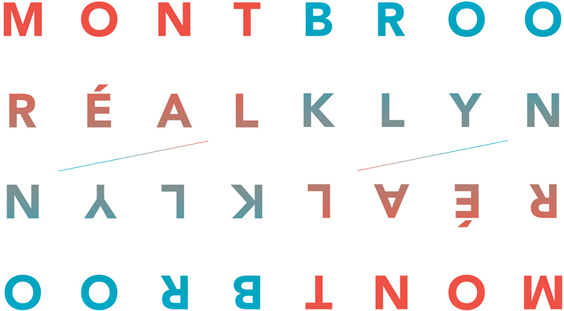
Montréal/Brooklyn
2 cities, 16 institutions, 40 artists
montrealbrooklyn.com
brooklynmontreal.com

One Reply to “Montréal / Brooklyn – in conversation with Claudine Khelil and Yann Pocreau, Montréal coordinators.”